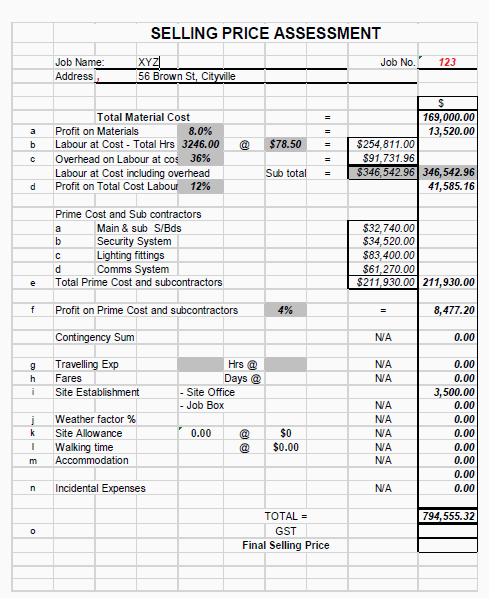From the ground up: estimating jobs
A foundation is designed to support the superstructure, and an estimate does the same job when tendering for a project. Brian Seymour explains.
The objective of the estimate is to secure a project at a price that will ensure a profit – not just prestige. Some contractors have boasted about winning a high-profile project, only to complete it at a loss.
The euphoria is intense when a quality tender is successful. However, when the congratulations are over the reality sets in and the whole team must focus on making a profit. It might not take very long for the highlight of the year to turn into trauma.
ADVERTISEMENT
There’s a quote attributed to Emmert Wolf – “A man is only as good as his tools” – and so it is with the estimator.
With the estimate as the foundation, there are several ways of increasing the profit on a project. By referring to the sample Selling Price Assessment (Figure 1) you can isolate sections of the project to see potential options.
In the hunt for a profit increase, project managers, supervisors and foremen too often focus on materials costs, and coercing subcontractors to reduce prices and cut overhead allocation.
Ethics must be involved when awarding purchase orders to the suppliers that helped you secure the project. Shopping around the suppliers that did not provide a quotation is unethical. Contractors with a reputation for doing so will not get the best price.
In any case, buying better should be kept in mind, especially when winning several large projects at the same time. Larger quantities give you buying power. Packages of lighting, cabling and switchboards sourced from the one supplier can attract additional discounts.
However, these actions are minor compared with what can be achieved by assembling a highly productive labour
force. Productive labour is defined as actual installation time versus planning, material handling, supervision, etc. The latter tasks should be done by nonproductive staff, not site personnel.
The following areas have the greatest effect on profit when not properly handled:
- Site meetings
- Detailing the scope.
- Setting a schedule.
- Initial schematic design.
- Site analysis.
- Procurement management.
- Managing tools and equipment.
- Ensuring power tools are in good working order and tagged.
- Ladders, steps, scaffolding, scissor lifts and cherry pickers meeting all OHS requirements.
- Discarding worn and damaged tools.
- Accident prevention.
With these tasks out of the way, the site foreman can concentrate on organising labour and the installation for maximum efficiency.
Material stockpiled far from the workface will result in many nonproductive hours that can never be recovered. Deliveries should be coordinated as follows:
- Materials arrive next to the workface.
- Staging is arranged to ensure zero delays.
- Best times are chosen to suit the site team.
- Materials handling equipment is available.
Moving labour between areas is non-productive and costly. To avoid detrimental conflict between trades it is essential to:
- Confirm working areas with all information, drawings, schedules and progress.
- Ensure availability of all tools and equipment.
- Ensure availability of all materials.
- Maintain frequent co-ordination with other trades.
The larger the installation team, the greater the chance of lost productivity. A site that is not co-ordinated will encourage the team to expand the hours to suit available materials and equipment, therefore:
- Eliminate repetitive tasks (moving equipment around the site due to inadequate delivery of materials or installation team schedules).
- Set targets in line with the building schedule.
- Practice good housekeeping – a place for everything and everything in its place.
- Aim for early detection of potential defects.
Any items that can be made or assembled off site will be more profitable than using site labour, and a well-trained team will consider these aspects:
- Cable looms.
- Special brackets and fixings.
- Lighting assemblies.
- Control boards.
There is greater potential for increased profit in labour saving than in materials and subcontractor prices. Each project and company has specific needs. This is a labour-intensive industry, and a job can quickly go belly up if you don’t keep track of labour usage.
Monitoring must start at the beginning of a project. It will be too late to make any adjustments when the job is more than half finished and before any productivity measurement is done. A well-prepared estimate will have each section calculated separately. This will be invaluable when assessing ‘cost to complete’ and progressive productivity.
A basic Selling Price Assessment includes the break-up of estimated prices to assist when considering profit increases. The accompanying sample is based on an $800,000, straightforward commercial project. Note the extreme left column shows the relevant code (a – o).
a. Your company’s choice.
b. This is the ‘loaded rate’ and will differ between states and awards.
c. Your company’s calculated OH rate.
d. Your company’s choice.
e. Total of all the major purchases.
f. Your company’s choice but is usually less than the materials profit because these are usually delivered in bulk by the suppliers and less material handling.
g. Depending on site agreement or award.
h. Depending on site agreement or award.
i. Require site shed, job box or storage cost?
j. If there is a large proportion of the work outdoors this needs to be considered.
k. Depending on contract conditions.
l. May be required on multi-storey structures or long distance between site shed and workface.
m. For remote sites.
n. Such as cranage, storage, meals, tea/coffee stations, local permits, parking fees, protective clothing, OHS training, toolbox meetings, income protection insurance, site transport, inspection fees, as-built drawings, etc.
o. GST if applicable.
Note that the loaded rate includes:
- Hourly wage.
- Travel.
- Fares.
- Superannuation.
- Annual leave loading.
- Long service leave.
- Payroll tax.
- Severance.
- Income protection.
- Workers’ compensation.
The rate used in this sample is an average figure and can vary extensively. Companies with more sophisticated estimating programs may be able to enter the loaded rate for each labour category – for example, foreman, leading hand, tradesman, apprentice – and will base the labour make-up on the proposed installation team.
-
ADVERTISEMENT
-
ADVERTISEMENT



